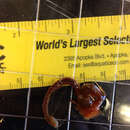en
names in breadcrumbs


Der Fadenbüschelwurm oder Nordische Rankenwurm (Cirratulus cirratus) ist ein sessiler, als Filtrierer lebender Vielborster (Polychaeta), der eingegraben in Schlamm oder Sand im Atlantischen Ozean und der Nordsee zu finden ist.
Der Fadenbüschelwurm hat einen zylindrischen Körper, der bei einer Länge von bis zu 30 cm etwa 150 Segmente zählt. An den Seiten des stumpf kegelförmigen Prostomiums sitzen 4 bis 8 große schwarze Augen. Die darauf folgenden, einander sehr ähnlichen 3 Segmente haben gerade Ränder. Zwei Gruppen von 2 bis 24 Palpen sitzen an der vorderen Kante des ersten borstentragenden Segments. Die langen, fadenförmigen Kiemen, die etwa so groß wie die Palpen sind, sitzen an jedem Segment, beginnend mit dem ersten borstentragenden Segment und fast bis zum Schwanzende. An allen borstentragenden Segmenten befinden sich kapillarförmige Borsten, doch sitzen ventral vom 10. bis 12. und dorsal vom 20. bis 23. Segment auch kurze, kräftige Borsten. Der Körper ist orange oder rosa bis bräunlich rot, die Kiemen und die Palpen rot bis gelb.
Der Fadenbüschelwurm ist im gesamten Atlantischen Ozean, in der Nordsee, dem Skagerrak und Kattegat bis zum Öresund verbreitet. Der Polychaet lebt in den tieferen Uferzonen in Schlamm oder schlammigem Sand oder zwischen Felsen, meist in Gruppen von bis zu 200 Individuen.
Der Fadenbüschelwurm ist getrenntgeschlechtlich. Die paarungsbereiten Weibchen nehmen durch die zahlreichen Eizellen in ihrem Coelom eine hellgelbe, die Männchen durch das Sperma eine weiße Färbung an. Beide Geschlechter entlassen ihre Gameten ins freie Meerwasser, wo die in einer Gallertmasse an festem Substrat verankerten dotterreichen Eier von den Spermien befruchtet werden. Nach sechs Tagen schlüpfen frei schwimmende Post-Trochophora-Larven, die sich von Dottervorräten ernähren und nach etwa 24 Tagen niedersinken und zu kriechenden Würmern metamorphosieren, um sich ins Sediment einzugraben und sessil als Filtrierer zu leben. Ein Weibchen kann alle 1 bis 2 Jahre Eier legen und tut dies 2- bis 3-mal in seinem Leben. Es gibt keine feste Paarungszeit im Jahr.
Der Fadenbüschelwurm ernährt sich als Filtrierer von Detritus und mikroskopischen Algen, die er mit seinen Tentakeln direkt aus der Wasserströmung oder an aufgewirbelten Bodenpartikeln auffängt und durch Wimperntätigkeit zum Mund transportiert.
Der Fadenbüschelwurm oder Nordische Rankenwurm (Cirratulus cirratus) ist ein sessiler, als Filtrierer lebender Vielborster (Polychaeta), der eingegraben in Schlamm oder Sand im Atlantischen Ozean und der Nordsee zu finden ist.
Cirratulus cirratus is a species of marine polychaete worm in the family Cirratulidae. It occurs in the littoral and sub-littoral zones of the Atlantic Ocean.
Polychaetes, or marine bristle worms, have elongated bodies divided into many segments. Each segment may bear setae (bristles) and parapodia (paddle-like appendages). Some species live freely, either swimming, crawling or burrowing, and these are known as "errant". Others live permanently in tubes, either calcareous or parchment-like, and these are known as "sedentary".
Cirratulus cirratus grows to up to thirty centimetres long with up to 150 segments. It has a slender, orange, pinkish or brownish body. The prostomium or head is a blunt cone with a row of 4 to 8 large black eyes on either side. The first segment bears two groups of up to eight feeding tentacles. At intervals along the body there are pairs of long slender gills which look like a mass of reddish threads.[2] Short, blunt bristles are found on segments 10 to 12 and more on segments 20 to 23.[3]
Cirratulus cirratus is found along the coasts of north west Europe and also in the south Atlantic Ocean. It mostly occurs living in burrows on the lower shore in mud or muddy sand, often underneath or between rocks.[2]
Cirratulus cirratus is a filter feeder, catching particles floating past with its tentacles and conveying them to its mouth.[2]
The sexes are separate and the worms become sexually active spasmodically at intervals of one to two years. The males are white at this time and the females yellowish due to the oocytes in their coelom.[4] Once the oocytes have been fertilised, they are stuck to rocks in a jelly-like mass. They hatch after six days into ciliated post-trochophore larvae. These live off the yolk sac for about twenty-four days before settling and starting filter feeding.[5] Asexual reproduction by means of clones growing from the posterior of the worm have been recorded, but the taxonomic status of Cirratulus is under constant review and this report may refer to a different species.[6]
Cirratulus cirratus is a species of marine polychaete worm in the family Cirratulidae. It occurs in the littoral and sub-littoral zones of the Atlantic Ocean.
Polychaetes, or marine bristle worms, have elongated bodies divided into many segments. Each segment may bear setae (bristles) and parapodia (paddle-like appendages). Some species live freely, either swimming, crawling or burrowing, and these are known as "errant". Others live permanently in tubes, either calcareous or parchment-like, and these are known as "sedentary".
Cirratulus cirratus is een borstelworm uit de familie Cirratulidae. Het lichaam van de worm bestaat uit een kop, een cilindrisch, gesegmenteerd lichaam en een staartstukje. De kop bestaat uit een prostomium (gedeelte voor de mondopening) en een peristomium (gedeelte rond de mond) en draagt gepaarde aanhangsels (palpen, antennen en cirri).
Cirratulus cirratus werd in 1776 voor het eerst wetenschappelijk beschreven door O. F. Müller.
Bronnen, noten en/of referentiesCirratulus cirratus é uma espécie de anelídeo pertencente à família Cirratulidae.
A autoridade científica da espécie é O. F. Müller, tendo sido descrita no ano de 1776.
Trata-se de uma espécie presente no território português, incluindo a sua zona económica exclusiva.
Cirratulus cirratus é uma espécie de anelídeo pertencente à família Cirratulidae.
A autoridade científica da espécie é O. F. Müller, tendo sido descrita no ano de 1776.
Trata-se de uma espécie presente no território português, incluindo a sua zona económica exclusiva.